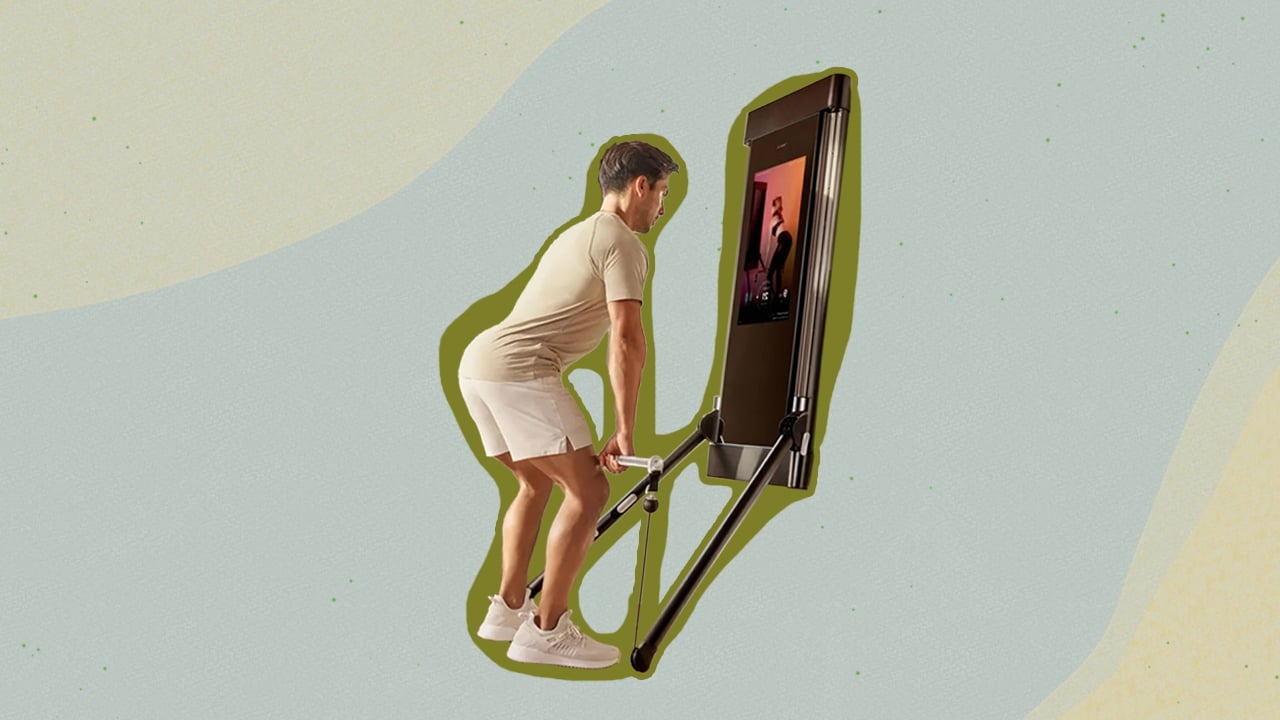Tonal Vs Mirror – Which Home Gym Is Better?
The Tonal smart home gym comes with a touchscreen and adjustable arms for personalized workouts, but it is pricey. In contrast, the Mirror offers a larger number and variety of classes, has a lightweight design, and is comparatively more affordable. When it comes to home gyms, Tonal and Mirror are two of the most popular […]

The Tonal smart home gym comes with a touchscreen and adjustable arms for personalized workouts, but it is pricey. In contrast, the Mirror offers a larger number and variety of classes, has a lightweight design, and is comparatively more affordable.
When it comes to home gyms, Tonal and Mirror are two of the most popular options available in the United States.
Both offer a variety of useful features and are designed to serve as an alternative to working out in a regular gym without compromising on fitness. However, there are several aspects where both machines differ from each other significantly.
And in this guide, I’ll be discussing those differences in detail.
Quick Specs Comparison

Tonal Attributes
Price: $2,995 | Installation Charges: $250 | Smart Accessories: $495 | Monthly Subscription: $49 | Dimensions: 50.9 x 21.5 x 5.25 inches | Screen Size:24-inch | Weight: 150 pounds | Risk-free trial: 30 days | Warranty: 3 years
Mirror Attributes
Price: $1,495 | Installation Charges: $250 | Smart Accessories: $200 – $550 | Monthly Subscription: $39 | Dimensions: 56 x 22.4 x 1.4 inches | Screen Size:40-inch | Weight: 70 pounds | Risk-free trial: 30 days | Warranty: 1 year
Hardware And Design
Both Tonal and Mirror have been designed after a lot of research, but they function very differently. Tonal allows a lot of physical interaction, thanks to its two adjustable arms that offer a maximum of 200 pounds of resistance.
Also, similar to a standard cable machine, Tonal has changeable attachments, such as a smart bar and smart handles equipped with Bluetooth. These attachments are provided by the brand itself, and if you want to use third-party attachments, you can use T-locks for that purpose.
Then there is a 24-inch touchscreen monitor, where you can make adjustments to workouts, access classes, and view your progress. This screen is similar to a computer monitor and has a built-in mic, speakers, and webcam, while the machine has internet and Bluetooth connectivity.
When this smart home gym is not being used, it takes minimal space, and you will just need about 7-feet by 7-feet of space around it. Only the adjustable arms that work using a pulley system will require additional space.
However, it will require professional installation and can only be installed on walls that support metal or wood studs, with a gap of 16 to 24 inches between them.
Then there is the Mirror, owned by Lululemon Athletica, which is not a physically interactive machine and does not come with a touchscreen monitor. Compared to Tonal, which looks like computer hardware, this has a regular screen that can be controlled using the mobile app available for smartphones.
This screen only works when the machine is being used, and has speakers, a mic, webcam and can be connected using Wifi or Bluetooth. Also, the Mirror only requires 2-feet of wall space for installation.
The Workout Content
To access the provided content, both Tonal and Mirror require you to sign up for a 1-year subscription. This subscription includes all workout classes, including live and on-demand ones, and after one year the smart home gyms can be used without a subscription. Also, both home gyms have a companion app for accessing the content on your smartphone.
With the Mirror, you get access to many different types of workouts across various categories. These include dance cardio, cardio bootcamp, barre, yoga, strength training, pilates, and more. Most of the content focuses on cardio, but many non-cardio workouts are also available. And these sessions make use of your fitness equipment, such as a barbell, kettlebell, resistance bands, dumbbells, workout mat, or even a stationary bicycle.
Then there are 15-20 live classes available each day, and you can even access additional personal training by paying $30 to $40 extra.
Compared to the Mirror, the content offered by Tonal is a bit limited. The video on-demand classes, in this case, include kickboxing, pilates, regular boxing, and many of the same options as offered by Mirror, but fewer options in each category.
Group workouts and live classes are currently in the testing phase, and Tonal does not offer personal training as of now. But it has a built-in personal trainer and tracks various metrics like power, consistency, and speed, along with real-time coaching and feedback.
Both machines connect with Apple Inc devices, like the Apple Watch, and can even monitor your heart rate using Bluetooth, but the Mirror also connects to Android smartwatches.
Price And Subscriptions
One of the first things I discovered while comparing Tonal and the Mirror is that they require considerable investment, much more than traditional workout equipment. And there is a major difference in the pricing between the two options.
The Tonal home gym starts at $2,995 without tax and delivery charges, and this price also does not include the cost of installation, smart accessories, or the monthly subscription. Tonal requires professional installation, which costs $250, and if you plan to get the smart accessories bundle, it will cost $495 more. The monthly subscription will cost $49 and is required for the first year of purchase.
While it is not mandatory to use the Tonal smart accessories, some types of workout accessories are recommended to get the most out of the machine. If you have similar ones at home or can get alternatives at a lower price, I would recommend those. Tonal also has other regular accessories, including a foam roller, fitness mat, workout bench, and rope attachment.
The Mirror is more affordable than Tonal, but at $1,495, it is still an expensive option. Like Tonal, the delivery and installation fee is $250, but it is currently not being charged. It also has a subscription business model, and the monthly subscription costs $39. But you can save money by getting a referral code from a friend who owns the machine.
With the Mirror, you get a floor stand and mounting hardware, and a starter pack is also available, which includes a heart rate monitor and a resistance band. Additional accessories can cost between $200 and $550 and include a exercise mat and a smart dumbbell.
Working Of The Smart Gyms
Now that I’ve covered all the technical aspects of both smart home gyms let’s look at how they function.
How Does Tonal Work
The adjustable arms of Tonal are what help differentiate it from other smart gyms. These have attached cables and are designed to provide a full body workout, as opposed to just strength training workouts offered by most competing machines. The arms can move up and down just like in traditional cable machines and can be used as smart weights in different configurations.
So, you can use them to perform bodyweight exercises like a squat or a pulldown using the handles, and the cables use electromagnetic resistance to alter their weight. This means there is no need to use heavy metal plates, a feature I found quite useful.
Both arms together offer 200 pounds of weighted resistance, which is slightly less than a ton and can be turned on or off using the smart accessories of the brand. The machine also utilizes technology effectively and has 17 built-in sensors to track your form and movements, enabling it to adjust the resistance, strength, and other aspects accordingly.
Similarly, Tonal uses artificial intelligence and provides feedback immediately during live workouts. With this machine, it is possible to train at your own pace. And Tonal’s home gym continuously tracks your progress and uses this data to suggest the most suitable resistance for the next strength training session.
Sports performance, pilates, yoga, cardio, and many other studio classes can be accessed without needing any other home gym equipment. The 24-inch touchscreen allows you to browse the various options and controls, access the workouts, and monitor your progress. Live classes are available daily, and the classes that are missed are added to the library.
For yoga, aerobic exercise, and cardio classes, you just need to follow the on-screen instructions, and each bodyweight exercise can even be accessed on your phone. This can help ensure better health and peace of mind even while traveling.
How Does Mirror Work
The Tonal wall workout machine puts greater focus on strength training, while the Mirror home gym focuses on endurance, cardiovascular fitness, and mobility. Your Mirror membership will provide access to high-intensity interval training, and the fitness classes offered include pilates, kickboxing, dance cardio, yoga, ballet, HIIT, meditation, and more.
With the Mirror, you do not get any digital weight system, though you can use compatible exercise gear with it, like smart dumbbells. These dumbbells can be paired with ankle weights and come with built-in sensors for movement tracking. That said, this workout mirror does not have any sensor of its own.
The maximum weight, in this case, is just 35 pounds, much less than that offered by Tonal, making the latter better for resistance training. But when it comes to being able to watch your form while training, I found the Mirror to be more useful.
Additionally, this wall-mounted gym has a built-in camera, allowing your personal trainer to watch you and provide feedback. The camera automatically turns off when the workout classes are over to ensure privacy, and it even comes with a physical lens cap. Such sessions require an additional fee, which is $40 for a 30-minute session.
On-demand workouts are also available with this machine, and over 10,000 physical fitness classes can be accessed currently.

Advantages Of Tonal Smart Home Gym
1. Personalized Workout Programs
While Tonal may not offer as many workouts as the Mirror, the programs it does offer are highly personalized. They can be customized to meet your fitness goals by adjusting various parameters. What’s more, both recorded and live workouts come with automatic weight suggestions for the most effective weight training.
2. Progress Tracking
As I mentioned, the Tonal smart gym has 17 sensors, including a motion detector that track various metrics while training. These include motion, range of motion, volume and power, muscle groups being exercised, sets, reps, body weight, and more. Monitoring these metrics over time provides information that can help you track your progress and set future workout goals.
3. Smart Accessories
To make your fitness routine more effective, you can get the Tonal smart accessories kit for training purposes. This kit includes smart handles and a smart bar that makes using the smart gym more convenient. The smart handles have buttons that allow turning the resistance on or off as required during resistance training.
4. Unlimited User Accounts
The $49 per month Tonal membership subscription allows you to set up unlimited user accounts. This means that all your family members can train using this smart home gym on a single subscription. What’s more, each member can save their stats and preferences for greater convenience.
Disadvantages Of Tonal Smart Home Gym
1. Extremely Costly
With a starting price of $2,995, Tonal is one of the most expensive home gyms currently available. And this does not include the cost of installation, delivery, smart accessories, or the one-year subscription. Competing options like the Mirror are comparatively more affordable, even after adding the cost of their accessories and membership plan.
2. Smart Accessories Not Included
This drawback is present with many smart home gyms, like the Mirror and Tempo Studio, not just Tonal. The machine does not come with any accessories and the Tonal smart accessories bundle costs $495. Without these accessories, the capabilities of the home gym are severely limited.
So, unless you already have compatible accessories, the total cost of the Tonal home gym will increase.
3. Considerably Heavy
Tonal weighs 150 pounds, making it one of the heaviest home gyms currently available. In comparison, the Mirror weighs just 70 pounds, which is less than half the weight of Tonal. This difference in weight is due to the fact that Tonal comes with adjustable arms that function like digital weights for weight-lifting purposes.
Such arms are missing on the Mirror, which is why it is lighter.
4. Requires The Right Type Of Wall
Tonal requires a floor space of at least seven feet by seven feet with a ceiling height of seven feet and ten inches. But more importantly, the wall-mounted home gym requires the right type of wall with the proper thickness. Because of this reason, it is not ideal if you are renting the space.

Advantages Of Mirror
1. Minimalist Design
Similar to other workout mirrors people use for training at home, the Mirror has a sleek and lightweight design. It does not have additional parts like moving arms like Tonal and weighs only 70 pounds. Being less than two inches thick, this smart home gym takes up as much space as a regular mirror, and it is not necessary to mount it on a wall.
2. Huge Selection Of Classes
The biggest advantage of the Mirror over other home gyms is the huge number of classes that are available when you get a membership. There are over 10,000 on-demand classes that can be accessed, and more are added every day. So, there are classes for every fitness goal, whether you want to build muscle, lose weight, or increase strength.
3. Real Trainers
With the Mirror, it is possible to connect with a real coach who can guide you through various workouts and provide feedback. This is possible thanks to the built-in camera, which is a useful feature for fitness enthusiasts who prefer a real trainer who can also provide motivation and encouragement. With other options, like Tonal, this is not possible.
And it can be especially beneficial for beginners who want guidance from a real person while training.
4. Multiple User Profiles
The Mirror offers a maximum of six profiles with one membership subscription, which is good enough for most users. Having multiple profiles is very handy if you intend to share the home gym with a partner or other family members. Each person can customize their profile as required to access their personal workouts and settings.
Disadvantages Of Mirror
1. Accessories Available Separately
You will need to get the accessories for the Mirror separately, as they are not included with the home gym. Depending on the accessories, these can range from $200 to $550, so the overall price of the smart home gym will be much higher.
2. Lacks Touchscreen
The Mirror does not have a touchscreen like the one on Tonal. This touchscreen can make it very easy to select workouts, adjust the settings, and navigate through the various options.
3. One Year Subscription Required
You will need to get a subscription during the first year and it will cost $39 per month, again adding to the overall cost of the machine. Without this subscription, you will not be able to take full advantage of its capabilities.

Tonal Vs Mirror Conclusion
When it comes to the Tonal and Mirror debate, there is no right answer, as both home gyms have useful features and can be used for different workouts. Which machine is better for you will depend on your personal training sessions.
If you’re looking for a high-tech home gym that offers a touchscreen, customized workouts, and unlimited accounts, then Tonal might be a better choice. It is also more suitable for users willing to spend a considerable amount of money to get the best workout experience at home.
On the other hand, the Mirror might be ideal if you want personal training and access to a larger number of exercises within a limited budget.
